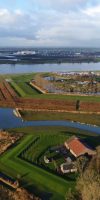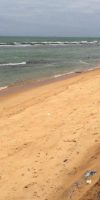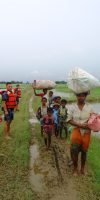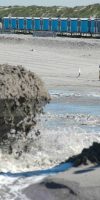Filter by:
News
Stay informed of all the latest developments in the field of water and subsurface.

Better understanding of storm surges in the future: the impact of a warmer climate
Due to rising sea levels and changes in storms, floods from the sea are expected to become more frequent in the coming decades. How the probability of a storm surge will change as a result of climate change has been studied by an international team, led by Deltares expert Sanne Muis and the Vrije Universiteit Amsterdam.
Deltares bridges gap at World Water Week and Vienna Water Conferences
The global water crisis challenges our current paradigms for water management, and urgently calls for action and innovation in science and policy. The UN 2023 Water Conference, which took place in New York earlier this year, was a moment to spur much-needed water action. This urgency was reiterated last week during the World Water Week in Stockholm and the Vienna Water Conferences (including the 40th IAHR World Congress, the World Large Rivers Conference, and the Danube Conference). Over 20 Deltares experts attended these events, bridging the gap between scientific research, policy formulation, and implementation. Their expertise is further strengthened by Deltares’ software offer for both policymakers and practitioners alike.
Linking sea-level research with local planning and adaptation needs
Studies on sea-level rise often claim to be useful for local decision-makers and adaptation planning. However, which results are most useful for local to global decision-making and what can researchers do to improve the utility of their findings? Researchers from Deltares, WorldBank, UC Berkeley and Utah State University gave their view on this question and published their results in Nature Climate Change. Deltares experts Ad Jeuken and Kees van Ginkel focused on the utility of global modelling studies for national-scale decision making.
Research into link between droughts and wildfires
In collaboration with WUR, Deltares has launched a study into the link between drought levels and the likelihood of wildfires in the Netherlands. Increasingly, wildfires last longer and affect larger areas. The recent large fires in Canada and Catalonia are cases in point. Earlier this year, there were also wildfires in our dune areas, and in Limburg and Brabant, with extensive damage as a result.
RA2CE Tool: Innovative Geohazard tool accelerates and optimises emergency response in Nepal
A few weeks ago, the United Nations World Food Programme (WFP) and Disaster Preparedness Network Nepal (DPNet) unveiled the RA2CE tool, aimed at improving emergency response in Nepal.
Bart van den Hurk elected as co-chair IPCC Working Group II
Today, professor Bart van den Hurk, Scientific Director at Deltares, has been elected as co-chair for the 7th Assessment Cycle of the IPCC’s Working Group II. The vote took place during the 59th IPCC plenary meeting in the headquarters of the United Nations Environment Programme in Nairobi, Kenya.
Reclaiming narratives for open climate adaptation futures
Narratives of the future matter in climate adaptation. The narrative that certain areas will inevitably become uninhabitable due to sea level rise is powerful but may silence important debate about alternative climate adaptation futures. This is the conclusion of a paper published today in Nature Climate Change by researchers from Deltares, Griffith University, University of Melbourne, Wageningen University, and the Pacific Theological College.-
Financing for ‘ReThink The Delta’ proposal not approved
Unfortunately, financing for the ‘ReThink The Delta’ proposal has not been approved by the National Growth Fund. The work done to produce the proposal generated a lot of inspiration and team spirit. We will be developing the philosophy further on the basis of the feedback and by working closely with the Ministry of Infrastructure and Water Management. 
Anniversary symposium 'Managing with water and soil'
Deltares celebrates 15 years! A special milestone that we celebrated with an anniversary symposium 'Managing with water and soil'. Three experts from Deltares, Marta Faneca, Thomas Bles and Ruben Dahm, told their inspiring stories about how densely populated deltas can remain liveable, sustainable and safe. “Look through the eyes of our children to clarify the plans for future water and soil management,” is the conclusion of the panel discussion with figureheads from the water and soil sector.
Smart use of sand to extend protection against sea level rise
The possibility of a much faster rise in sea levels poses major challenges for the Netherlands. An adaptive and flexible response to future sea level rise is an innovative way to prepare for that uncertain future. One way to go about this is coastal maintenance in the form of sand nourishments. Two recent studies by Deltares and partners, one of them commissioned by the Ministry of Infrastructure and Water Management as part of the Sea Level Rise Knowledge Programme, demonstrate that there are many options available for sandy coastal management, on condition that enough sufficient sand reserves continue to be readily available.-
Nature Based Solutions for climate resiliency in Europe’s Atlantic region
A consortium of 30 partners (in Denmark, Netherlands, Belgium, France, Spain, Portugal, Italy) will soon kick-off the project ‘Nature Based Solutions for Atlantic Regional Climate Resilience’, a Horizon Europe call, funded by the EC under contract 101112836. The consortium is led by Deltares. 
Smarter protection of quay walls through better understanding of propeller jets
Port and waterway authorities usually protect their infrastructure, such as quays and berths at locks, from erosion caused by ship propellers by installing bed protection. Recent research is improving the way the behaviour of currents caused by ship propellers during mooring and berthing is mapped with new measurement techniques and advanced calculations. The outcomes provide valuable knowledge for infrastructure managers. By designing bed protection smarter, managers can save on costs, materials and emissions. In this research, knowledge institutes Deltares and MARIN are working together with port companies, the Dutch Directorate-General for Public Works and Water Management (Rijkswaterstaat) and contractors.
